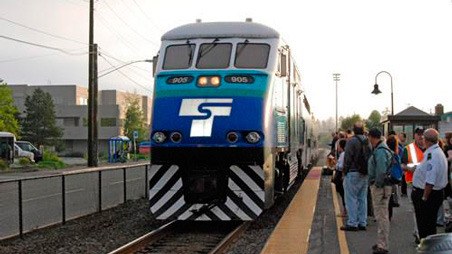A Kent City Council project to reduce train horns in downtown appears to be back on track.
Mill Creek neighborhood residents proposed the idea of a “quiet zone” to the council about six years ago because of the loud whistles heard at their homes. But the recession and other priorities derailed any plans to improve safety measures at railroad crossings to further separate vehicles and pedestrians from the tracks, so train engineers no longer need to blast their horns while going through 10 downtown intersections.
“Trains are loud,” said Chad Bieren, city Public Works engineer, at a council workshop on Tuesday. “It those horns aren’t blasting, it will be a significant reduction in the sound you’re going to hear if you are back from the tracks any amount.”
City staff continues to meet with Burlington Northern Santa Fe (BNSF) and Union Pacific (UP) railroad officials as well as the Federal Railroad Administration (FRA) to make determinations about improvements needed for a quiet zone.
About 50 trains (freight, Amtrak, Sounder) use the BNSF tracks each day and another 10 to 15 trains travel the UP tracks, according to city staff.
Bieren said he expects to return to the council in April or May with how much it would cost the city to upgrade the crossings with flashing lights, medians, gates, install signs and other measures.
The initial estimate is about $2 million, Bieren said. That cost is about $1 million lower than city estimates last year because of track improvements UP made as well as fewer wayside horns needed at intersections. A wayside horn is an automated warning system that involves a pole-mounted device that gives an audible warning to drivers and pedestrians. The sound of this system does not carry as far into surrounding neighborhoods as train whistles.
The council last July asked staff to study whether a local improvement district (LID) could be formed to help pay for a railroad quiet zone. A LID is an additional property tax fee charged to property owners who would benefit from the improvements.
“We’ve been moving forward with what we need to do to get a quiet zone in place before we look at a local improvement district,” Bieren said. “We need to get our arms around what the costs are going to be. If the costs are within reach, a local improvement district may be an option the council doesn’t want to move forward with.
“There’s a lot of complexity with a local improvement district, especially with the benefit of this as reduced horn noise. We are concerned that if you have a number of people opposed to paying for it, you get a lot of appraisers coming out of the woodwork that might say how do you put a dollar amount to train noise, and it could be difficult to move forward with it.”
Councilman Les Thomas asked staff about funds the city set aside a few years ago to help pay for a quiet zone.
“About $500,000 was set aside and it was later removed because of recession cuts,” city Public Works Director Tim LaPorte said about money transferred to the general fund to pay for other costs.
Once the city finalizes a quiet zone proposal, it must go to the FRA to approve the plan. The agency would help make sure the added safety measures at each intersection would be as safe or even safer than train engineers blowing their horns.
Some of the initial construction work could start this summer, LaPorte said.
“Having the horns blow a lot less frequently will be a bonus for them,” Councilman Dennis Higgins said about downtown merchants. “The folks who brought this to my attention initially were the folks who live in the Mill Creek neighborhood. They are in agony because they can’t sleep with their windows open in the heat of the summer. That’s really going to be a great addition to the quality of life for them.”
Higgins added that city staff has struggled to sell the city-owned Naden property north of Willis Street near the UP tracks because of train horn noise. He said people looking to rent downtown apartments also would appreciate not hearing train whistles.
Talk to us
Please share your story tips by emailing editor@kentreporter.com.
To share your opinion for publication, submit a letter through our website https://www.kentreporter.com/submit-letter/. Include your name, address and daytime phone number. (We’ll only publish your name and hometown.) Please keep letters to 300 words or less.

